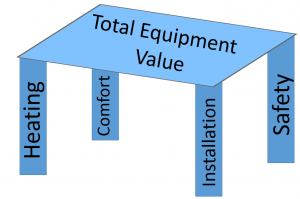For the last 3 years my team has been traveling North America visiting with Cambridge Engineering’s, Sales Representatives to spread the word about options available to Building Owners, Building Operators, Design Engineers, Contractors and Utilities when recommending and selecting heating and ventilation solutions for their building or retrofit projects.  We have been attempting to call out 3 core concepts for the key influencers when considering improvements to their buildings. 1.) Safety - Use of 100% outside air, direct fired HTHV and MAU technology is inherently safe. Ventilation and Heat are provided by the same blower that cannot be separated. These technologies can improve indoor air quality. Ventilation is the key to safety, preventing the buildup of products of combustion. 2.) Energy Efficiency - HTHV technologies provide the highest btus/cfm ratio thus creating more net useable btus or heat to satisfy the air load and the conductive load in high bay warehouses, distribution centers and manufacturing facilities. 3.) Lowest Total Installed Cost - HTHV technologies deliver 3 system in 1 piece of equipment. HTHV technologies deliver A.) Heat, B.) Fresh air ventilation and C.) Even temperatures throughout the building. This 3-in-1 system reduces total equipment cost and the installation costs associated with connections necessary to install multiple pieces of equipment. Engineers may call this a cleaner design. During our recent Contractor Advisory Board, an influential Design Build Contractor, Paulson-Cheek (Atlanta, Georgia), called us out on our failure to identify THERMAL COMFORT as a primary value in his selection and use of HTHV equipment in his high bay building designs. I’d like to share a brief video from Marshall Cheek regarding his comments on this subject:
We have been attempting to call out 3 core concepts for the key influencers when considering improvements to their buildings. 1.) Safety - Use of 100% outside air, direct fired HTHV and MAU technology is inherently safe. Ventilation and Heat are provided by the same blower that cannot be separated. These technologies can improve indoor air quality. Ventilation is the key to safety, preventing the buildup of products of combustion. 2.) Energy Efficiency - HTHV technologies provide the highest btus/cfm ratio thus creating more net useable btus or heat to satisfy the air load and the conductive load in high bay warehouses, distribution centers and manufacturing facilities. 3.) Lowest Total Installed Cost - HTHV technologies deliver 3 system in 1 piece of equipment. HTHV technologies deliver A.) Heat, B.) Fresh air ventilation and C.) Even temperatures throughout the building. This 3-in-1 system reduces total equipment cost and the installation costs associated with connections necessary to install multiple pieces of equipment. Engineers may call this a cleaner design. During our recent Contractor Advisory Board, an influential Design Build Contractor, Paulson-Cheek (Atlanta, Georgia), called us out on our failure to identify THERMAL COMFORT as a primary value in his selection and use of HTHV equipment in his high bay building designs. I’d like to share a brief video from Marshall Cheek regarding his comments on this subject:
Marshall’s callout on Thermal Comfort was very insightful. We often undervalue the importance of building occupant comfort in a cost competitive new construction or retrofit building environment. Understanding the importance of creating a safe and comfortable working environment for people engaged in the real physical activity such as: warehousing, distribution center and manufacturing facilities, compels us to add this 4th leg to the table.  Are people more productive when their workplace is comfortable? One ergonomics expert, Chris Adams, who in addition to being a Human Factors Engineer & Industrial Designer, has been providing human factors engineering to NASA, states that: temperature has a major impact on productivity. According to one of Chris’s articles, 71.5 F is the optimal temperature for 100% productivity. His report details the following information: As temperature increases at: • 77 degrees fahrenheit we're about 98% productive • 82 degrees fahrenheit = 95% • 87 degrees fahrenheit = 90% • 92 degrees fahrenheit = 85% As temperature decreases at • 66 degrees fahrenheit we're about 98% productive • 63 degrees fahrenheit = 95% • 59 degrees fahrenheit = 90% Soliciting solid Building Owners and Building Operators’ input during the design phase of one’s building project makes sense, according to this report. Adding personnel comfort level to our discussions and being able to articulate the impact that consistent temperatures may have on people’s productivity is beneficial. Inherent Equipment Safety, Energy Efficiency, Lowest Total Installation Cost and People Comfort are all important topics of discussion when discovering what is most important to owners and operators. People Comfort is high on my list of questions. What does a 5% gain in productivity mean to an organization in real dollars? Answer this question and compare it to an investment decision and it makes for better decision making in an equipment selection. Thanks for sticking with me to the end here. How important have you found thermal comfort to be in your conversations regarding HVAC design? Does the same hold true for people working in the warehouse? Should it? 71.5d egrees fahrenheit sounds good right now as it’s 100 degrees fahrenheit in St. Louis as I write this blog post.
Are people more productive when their workplace is comfortable? One ergonomics expert, Chris Adams, who in addition to being a Human Factors Engineer & Industrial Designer, has been providing human factors engineering to NASA, states that: temperature has a major impact on productivity. According to one of Chris’s articles, 71.5 F is the optimal temperature for 100% productivity. His report details the following information: As temperature increases at: • 77 degrees fahrenheit we're about 98% productive • 82 degrees fahrenheit = 95% • 87 degrees fahrenheit = 90% • 92 degrees fahrenheit = 85% As temperature decreases at • 66 degrees fahrenheit we're about 98% productive • 63 degrees fahrenheit = 95% • 59 degrees fahrenheit = 90% Soliciting solid Building Owners and Building Operators’ input during the design phase of one’s building project makes sense, according to this report. Adding personnel comfort level to our discussions and being able to articulate the impact that consistent temperatures may have on people’s productivity is beneficial. Inherent Equipment Safety, Energy Efficiency, Lowest Total Installation Cost and People Comfort are all important topics of discussion when discovering what is most important to owners and operators. People Comfort is high on my list of questions. What does a 5% gain in productivity mean to an organization in real dollars? Answer this question and compare it to an investment decision and it makes for better decision making in an equipment selection. Thanks for sticking with me to the end here. How important have you found thermal comfort to be in your conversations regarding HVAC design? Does the same hold true for people working in the warehouse? Should it? 71.5d egrees fahrenheit sounds good right now as it’s 100 degrees fahrenheit in St. Louis as I write this blog post.